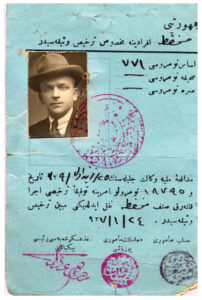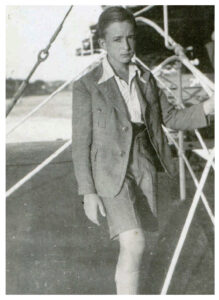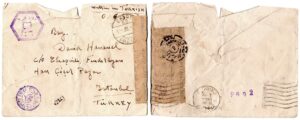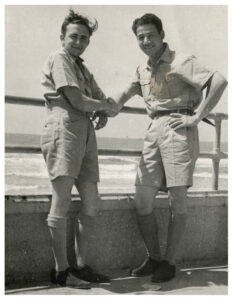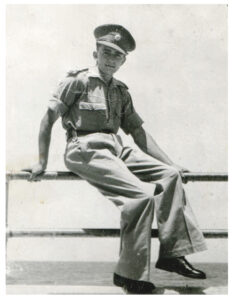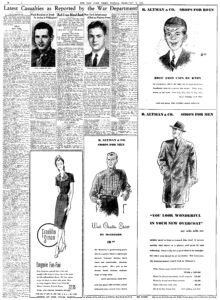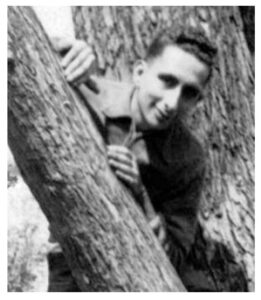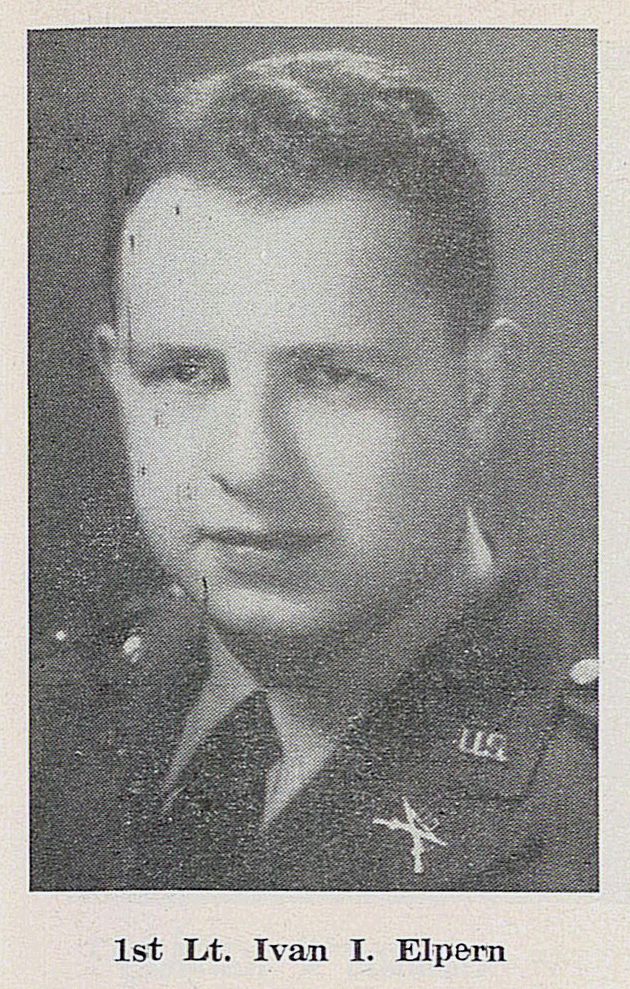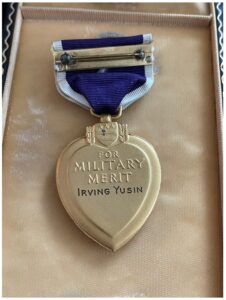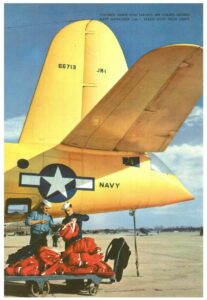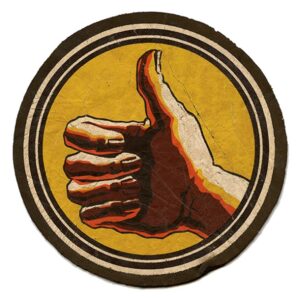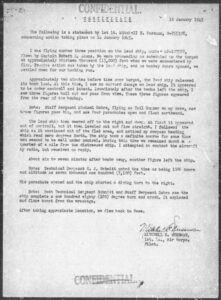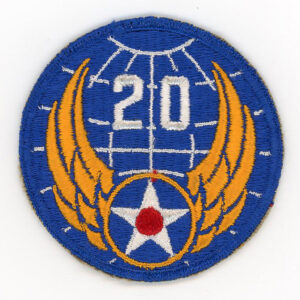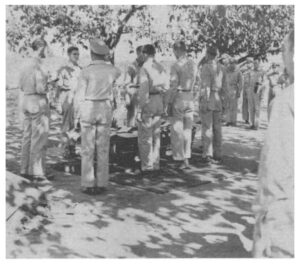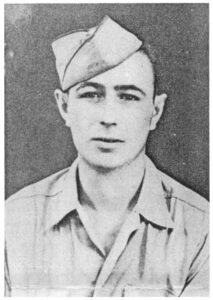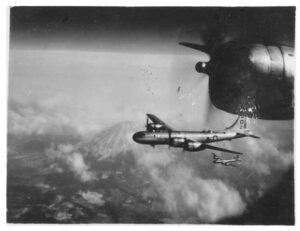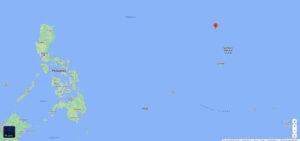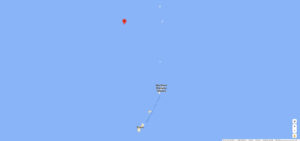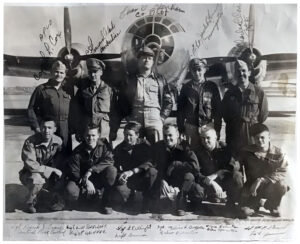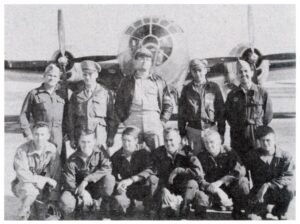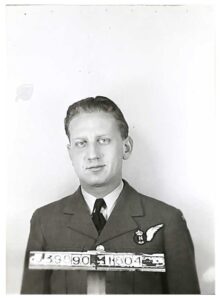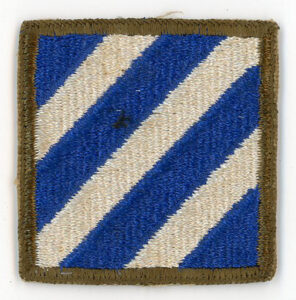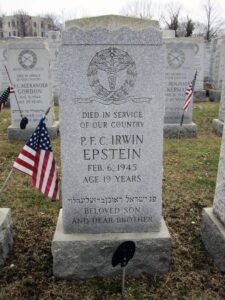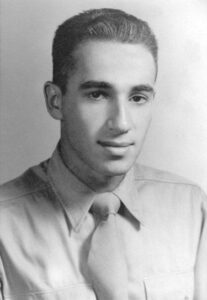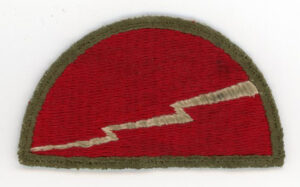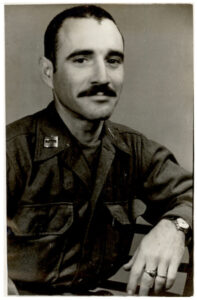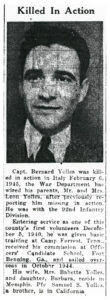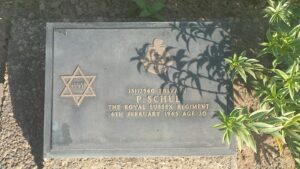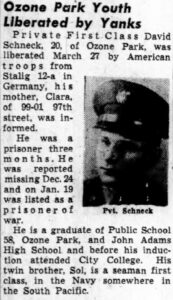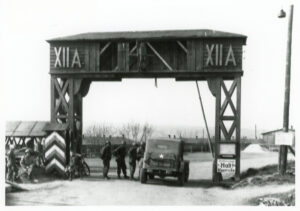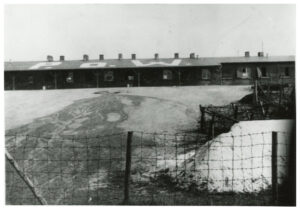This is the second of two posts concerning Jewish military casualties in the Second World War, specifically on January 14, 1945.
But, some brief words of explanation…
The “first” post, “Soldiers from New York: Jewish Soldiers in The New York Times, in World War Two: Captain Arthur H. Bijur – January 14, 1945 [“New and improved…!” – Part I]”, focuses on Jewish servicemen in the armed forces of the Allies who served in the ground forces of the Allied armed forces, and, as aviators in a variety of military units. By design, that post isn’t complete: It’s absent of information about Jewish aviators in the United States Eighth Air Force who were casualties – two killed in action; five prisoners of war – on that January Tuesday seventy-eight years ago. Due to the sheer abundance of information about the Eighth Air Force and its air war against the Third Reich, their stories appear in this very lengthy post.
Well, all my posts are lengthy.
(!)
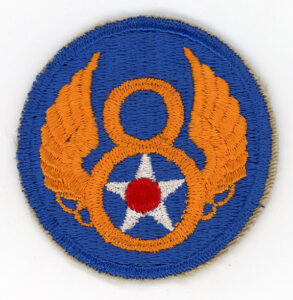
______________________________
Sgt. Fred Leiner
– .ת.נ.צ.ב.ה. –
…Tehé Nafshó Tzrurá Bitzrór Haḥayím …
May his soul be bound up in the bond of everlasting life.
1st Air Division, 8th Air Force, 381st Bomb Group, 535th Bomb Squadron
The insignia of the 535th Bomb Squadron…
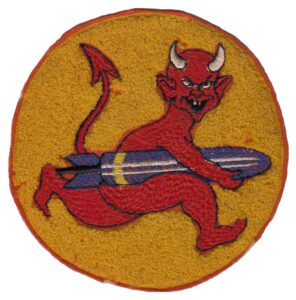
During a mission to Rodenkirchen (a southern borough of the city of Cologne, Germany), the 381st Bomb Group’s 535th Bomb Squadron endured the loss of a single aircraft: B-17G 42-97313, MS * N, nicknamed “THE COLUMBUS MISS” / Egg Haid and piloted by 2 Lt. Mead K. Robuck. According to Missing Air Crew Report 11763, the aircraft was last sighted flying in the 381st’s formation at 24,800 feet. The group received meager to accurate and continuous following (anti-aircraft) fire, but unlike the 8th Air Force’s 3rd Air Division – about which far more below – didn’t come under attack by Luftwaffe fighters. However, “THE COLUMBUS MISS” was seen to have received a flak hit in its #3 (starboard inboard) engine, and when last seen was reportedly under control. (Flak similarly accounted for the only other 1st Air Division B-17 lost on January 14: Aircraft 43-38911, OR * P, Bull Session, of the 91st Bomb Group’s 323rd Bomb Squadron, during that Group’s mission to Koln. Piloted by 2 Lt. William E. Meyer, the aircraft crashed at Wengerrohr, Germany, with only one survivor of its crew of nine: bombardier 2 Lt. James D. Buescher.)
The crew of “The COLUMBUS MISS” consisted of:
Pilot: Robuck, Mead K., 2 Lt. – Returned
Co-Pilot: Scarsdale, James W., 2 Lt. – Returned
Navigator: O’Brien, Raymond J., 2 Lt. – Returned
Flight Engineer: Sewell, Michael A., T/Sgt. – Returned
Radio Operator: Dicero, Joseph, S/Sgt. – Returned
Gunner (Ball Turret): Shott, Richard L., S/Sgt. – KIA
Gunner (Waist): Lavalle, Robert A.P., S/Sgt. – Returned
Gunner (Tail): Leiner, Fred, Sgt. – KIA
Photographed on May 30, 1944, here’s “THE COLUMBUS MISS”, in Army Air Force Photo B-65831AC / A46333.

Filed six days later, on January 20, MACR 11763 reported that, “All men on the aircraft believed to have bailed out after the aircraft had been hit by flak over the battle area. The men bailed out at approximately 50-14 N, 05-46E. On this day, it was possible for the chutes to fall either in German lines or American lines.”
As of January 23, Lt. Robuck and six of his eight crew men – his co-pilot, navigator, bombardier, radio operator, flight engineer and waist gunner – had been accounted for. Based on consolidated statements by Lt. Robuck, navigator 2 Lt. Raymond J. Brien, and togglier S/Sgt. James C. Adkins, the 381st’s S-2 (Intelligence) Officer reported that the entire crew was believed to have bailed out over the battle area, at approximately 50-14 N, 05-64 E, concluding with the ambiguous statement, “On this day, it was possible for the chutes to fall either in German lines of American lines.”
With this, the MACR carries no further information about the two missing sergeants, their “Current Status” (current as of 1/23/45, that is) having been reported as “MIA”. The Report’s likewise absent of next-of-kin and residential address for the missing men. Or anything else, for that matter.
The report suggests that at least one of the missing men – and maybe both? – descended into German lines, which – would suggest that the men were taken prisoner, implying – given that they eventually known to have been killed in action – that they did not survive capture. But, this turns out not to have been the so.
In reality, as suggested in postwar correspondence by Lieutenants Robuck and Brien, and Sergeant Adkins – see below – and solidly confirmed in other documents in Sergeant Shott’s Individual Deceased Personnel File, neither man ever left the bomber, the wreckage of which was found north of Warempage, Belgium, ½ mile north of Les Failles (approximate position 50-08 N, 05-38 E). The IDPF reveals that bodies of both men were found near their crashed B-17.
The probable crash location of “THE COLUMBUS MISS” is denoted by the small red circle in the center of this Oogle map. Though not visible here, Bastogne is only a few miles south.
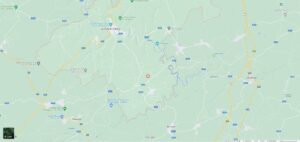
What happened, actually? Both men were seen, uninjured, in the plane’s rear fuselage as other crewmen exited the damaged bomber, Sgt. Shott standing near his just-vacated ball turret, and Sgt. Leiner crawling out of his tail gun position. It seems that the two gunners succumbed to anoxia and never left the “THE COLUMBUS MISS”.
Here’s postwar correspondence from Mead K. Robuck, Raymond J. O’Brien, and James C. Adkins, concerning the two missing crewmen.
First, O’Brien’s letter of November, 1945

27 Walnut Street
Rutherford, N. J.
November 22, 1945
Lt. Col. John T. Burns
Officer in Charge
Status Review and Determination Section
Washington, D. C.
Dear Sir:
Subject: Casualty Information No 4975. The following is in answer to your request of the 14th of November:
A. Type of damage to plane.
1. We received a hit from what we believe to have been a 105 mm. anticraft gun. The shell seems to have gone off slightly in front of the number three engine nacelle. This hit set both wings and the nose on fire and put numerous holes in the forward part of the ship. As far as I have been able to determine, there was no damage to the tail or ball turret. The plane exploded when it hit the ground or was very low. I was able to see the plane most of the way down when I was in my parachute.
B. Personal knowledge.
1. I did not personally see anything of the two men mentioned.
C. Information received from others.
1. Staff Sgt. Robert LaValle, who was flying as waist gunner, told me the following: Before he left the aircraft, Sgt. Shott was out of the ball turret and was on oxygen and had his parachute. Sgt. Liener [sic] was crawling out of the tail compartment and did not have his oxygen mask connected or have his parachute. Sgt. Dicero, radio operator, also said Sgt. Shott was out of the ball turret. The men on the ground had varying ideas as to the number of chutes. The maximum was six and three were some reports of one chute that did not open. The other crews reported up to six chutes, however, seven men were known to have parachuted safely.
D. Location of Incident.
1. We were approximately five miles southeast of Hauffalize. The plane was estimated by ground troops to have crashed in or very close to the British zone of operations.
E. Additional information.
1. I have heard from men in my group that movies were shown of our plane going down in which our ship is recognizable. If these actually exist, they may be of some help.
This is all the knowledge I have on the subject. Any points not clear, I shall be glad to elaborate upon request.
Very truly yours
/s/ R.J. O’Brien, Jr.
1st Lt. ACAUS
(Inactive)
__________
Second, Adkins’ letter of December, 1945

EATON MANUFACTURING COMPANY
CLEVELAND, OHIO
COPY
December 3, 1945
Edward F. Witsell
Major General
Acting The Adjutant General of the Army
RE: AGPC-S 704
Dear Sir:
In your letter of November 28th, you asked me to give you certain information on Staff Sergeant Richard L. Shott, 15401567 and Sergeant Fred Leiner, 11058059.
1. Type of damage to the plane: The #3 engine was blown out by flak, oxygen and communications entirely ruined, plane was thrown out of control and vibrated furiously, both wings were aflame.
2. Personal knowledge: I was sitting in the nose compartment of our B 17 G. The last thing I remember was the Ball Turret gunner saying that he saw flak at 12 o’clock low. The crew didn’t have flak suits on because we were in friendly territory. All of a sudden I felt my oxygen mask tighten. The first thing I did was reach for my parachute as the plane was thrown out of control. I turned around and saw the Navigator crawling towards the escape door. At this time the copilot baled out, after the co-pilot, the Navigator and then I baled out. I couldn’t move my head as I was caught in my parachute. I saw two chutes below me and the plane in flames.
3. Hearsay information: The radioman was the first to realize the extent of the damage. He noticed by glancing out the side window the plane was in flames and he ran through the radio room and waist to the escape door. He had his parachute on. As he ran through the waist he noticed the Ball Turret was up and the gunner was reaching for his parachute. He noticed too, the tail gunner was crawling from his compartment to the waist. The tail gunner didn’t have his parachute in his compartment and had to crawl to the waist to get it.
At this time, the radioman passed out from lack of oxygen. The waist gunner who already had his chute on said he knows the ball gunner had his chute on too. He didn’t know about the tail gunner’s condition. The waist gunner pushed the radioman out of the plane and fell out after him. They do not know if the ball gunner and tail gunner still had enough oxygen to get out of the plane or not, but we are certain that the pilot was in the plane much longer than this and he did not pass out from lack of oxygen. The crew believes the pilot was the last man to leave the ship. Reports from paratroopers who picked me up were that they saw eight parachutes come down. I wouldn’t call this correct because every person I talked to seemed to have a different number as to the chutes that came down.
I was watching the instruments so I know the altitude of the plane was 27,000 feet, air speed was 160 mph. We baled out over Bertogne, Belgium, which was liberated an hour before the time we baled out, so that some of the crew fell on the enemy’s side and some on our side.
I believe that definite information can be received from our waist gunner, Robert Lavalle, who was on the crew at the time of the accident. This seems to be all I can remember and hope that it is of some help.
Respectfully yours,
James C. Adkins
19311 Arrowhead
Cleveland, Ohio
__________
Third, Adkins’ letter of April, 1946

SPQYG 293
86865
(neuville-en-Condroz)
Belgium
April 5, 1946
The Quartermaster General
Memorial Division
Washington 25, D. C.
Dear Sir:
In reply to your letter of April 1st, I am enclosing a letter I had written on December 3, 1945 to the Acting Adjutant General of the Army.
Have you definitely identified the plane that crashed in the vicinity of Les Tailles, Belgium, as the one that belonged to our crew. I landed approximately one mile from the spot you mentioned and know nothing about the landing of Sgt. Fred Leiner, 11058059, and Richard L. Shott, S/Sgt., 15401567. I don’t even know if they were killed in the plane crash, or if they were taken prisoners. For all I know they may even be alive somewhere in Europe.
Have you been able to identify these two as the two men that died in the crash, or have you found two men and can’t identify them? Have you definite evidence that Fred Leiner and Richard Shott are dead or is their case still opened as being missing. I would appreciate any definite information you can give me, as I would like to know just what did happen to these two.
If there is anything more I can do please let me know.
Respectfully yours,
James C. Adkins
19311 Arrowhead
Cleveland 19, Ohio
JCA:jh
__________
Finally, Robuck’s letter later that same month.
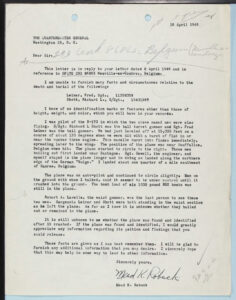
26 April 1946
THE QUARTERMASTER GENERAL
Washington 25, D. C.
Dear Sir:
This letter is in reply to your letter dated 8 April 1946 and in reference to SPQYG 293 86865 Neuville-en-Condroz, Belgium.
I am unable to furnish many facts and circumstances relative to the death and burial of the following:
Leiner, Fred, Sgt., 11058059
Shott, Richard L., S/Sgt., 15401567
I know of no identification marks or features other than those of height, weight, and color, which you will have in your records.
I was pilot of the B-17G in which the two above named men were also flying. S/Sgt. Richard L. Shott was the ball turret gunner and Sgt. Fred Leiner was the tail gunner. We had just leveled off at 25,000 feet on a course of about 130 degrees when we were hit with a burst of flak in or near the number three engine. This nacelle burst into flames immediately, spreading later to the wing. The position of the plane was near Houffalize, Belgium when hit. The plane started to circle to the right. Those men bailing out first landed near Bastogne. Sgt. Sewell, the engineer, and myself stayed in the plane longer and in doing so landed along the northern edge of the German “Bulge.” I landed about one quarter of a mile southwest of Samree, Belgium.
The plane was on auto-pilot and continued to circle slightly. Men on the ground with whom I talked, said it seemed to be under control until it crashed into the ground. The bomb load of six 1000 pound RDX bombs was still in the plane.
Robert A. Lavelle, the waist gunner, was the last person to see these two men. Sergeants Leiner and Shott were both standing in the waist section as he left the plane. As far as I know it is unknown whether they bailed out or remained in the plane.
It is still unknown to me whether the plane was found and identified after it crashed. If the plane was found and identified, I would greatly appreciate any information regarding its position and findings that you could release.
These facts are given as I can best remember them. I will be glad to furnish any additional information that you may desire. I sincerely hope that this may help in some way to lead to other information.
Sincerely yours,
Mead K. Robuck
__________
Listed on page 169 of American Jews in World War II, and page 442 of Gerald Astor’s The Mighty Eighth, Sgt. Fred Leiner (11058059), born in Brooklyn on September 8, 1924, was the son of Benjamin (7/12/96-9/84) and Lena (Lea) (Herscher) (12/12/97-1/7/63) Leiner, of 37 Columbia Street, in Wooster, Massachusetts. He’s buried at Plot A, Row 8, Grave 24, of the Netherlands American Cemetery, in Margraten, Netherlands. His military awards of the Air Medal and Purple Heart suggest that he completed between five and ten combat missions.
From Ancestry.com, this portrait of Fred Leiner is his graduation portrait from the 1942 Wooster Classical High School Yearbook.

Also buried in Europe (at Plot A, Row 28, Grave 8, in the Ardennes American Cemetery) is Staff Sergeant Richard L. Shott.
______________________________
________________________________________
______________________________
A Bad Day Over Derben
Perhaps inevitably, given the tactics and technology of aerial combat of the Second World War, let alone the global conflict’s duration – there were numerous occasions during the war when Allied air forces experienced strikingly if not staggeringly high combat losses. Among the most well known occasions, at least in terms of popular knowledge (and these are only three examples of – alas – very many) are the Ploesti Mission of August 1, 1943, the Schweinfurt-Regensburg mission of August 17, 1943, and the Royal Air Force’s mission to Nuremburg on the evening of March 30-31, 1944. However, in terms of the United States Army Air Force, there were frequent instances when relatively smaller numbers of aircraft were lost, but … which still eventuated in the annihilation of entire combat squadrons or even the majority of aircraft within a single Combat Group. Examples include the 455th Bomb Group’s mission to the Mosobierbaum Oil Refinery in Austria on June 26, 1944, the 483rd Bomb Group’s mission to Memmingen, Germany, on July 18, 1944; the 2nd Bomb Group’s mission to the Privosier Oil Refinery, at Moravska Ostrava, Czechoslovakia, on August 29, 1944, and the 491st Bomb Group’s mission to Misburg, Germany, on November 26, 1944.
A similar event occurred on January 14, 1945, when the 8th Air Force lost sixteen B-17s among four different 3rd Air Division bombardment Groups during a strike against German petroleum targets. Among the sixteen planes were nine aircraft of the 390th Bomb Group, including all seven from the Group’s 568th Bomb Squadron. In terms of events and tactics, the Group’s debacle on this January Tuesday shares strong similarities with the loss of sixteen B-24s during the above-mentioned Misburg mission. The central parallels are the “lost” squadron having first become spatially separated from other squadrons in its Group, and made vulnerable by this separation from the collective firepower of its brother squadrons, drawing attacks by Luftwaffe fighter aircraft. Or, as described by Roger Freeman in The Mighty Eighth:
On January 14th a force of over 600 heavies engaged in the Eighth’s first large scale strategic mission since the Ardennes emergency. With a bright clear day promised the operational planners turned to their first priority, oil, sending part of the 2nd and all the 3rd Division to refineries and storage sites in Northwest Germany. A strong force of Mustangs cossetted the bombers, anticipating that the combination of a fine day and an oil target would bring the Luftwaffe to battle. The Mustangs, however, managed to deflect the majority of enemy fighters before they reached the bombers.
North-west of Berlin the escort for the head of the 3rd Division column surprised a whole Geschwader preparing for a “company front” assault. About a score of FW-190s, with a few Me-262s and Me-109s covering them, managed to get to the 95th Group, making single head-on passes which brought them no successes. Fortress gunners claimed five of the enemy and those of the 100th Group claimed eight in a similar fruitless attack by the same, or a similar, enemy force a little later. The third group of the Fortress wing, the 390th, was not so fortunate. Its low squadron, comprised of only eight aircraft, was lagging due to supercharger trouble in their leading aircraft. When the Luftwaffe appeared on the scene, this unit was flying some 2000 ft below and behind the rest of the group, presenting the obvious choice of target. The German fighters showed signs of inexperience, for they attacked mostly in pairs from the rear, without any apparent coordination and often opening fire at maximum range; it took them the best part of half an hour to dispatch the eight B-17s and one other from the main formation. The 390th gunners claimed a score and were allowed 14. For the Group it was their unluckiest day, the highest losses on a single mission and, incidentally, the last sustained assault by a Luftwaffe formation on a single Eighty AF heavy bomber unit.
The mission is described in more detail at the 390th Memorial Museum Foundation: “January 14, 2022 – On This Day in History – Derben, Germany: Jan. 14, 1945 – Mission 243”. (For sources of information of this section, see “390th Bomb Group Works Cited” in References, at bottom of post.)
370 B-17s & 331 P-51s from the Third Bombardment Division set out from England with orders to attack oil facilities in the cities of Derben & Magdeburg in eastern Germany.
While the underground oil storage facilities in Derben were considered low priority targets, General Carl A. Spaatz, commander of U.S. Strategic Air Forces in Europe, insisted that these targets of seemingly little value needed to be hit, saying, “The output of oil products has been reduced to the point where German reserves are now critical. Your task is to defeat his desperate attempts to rebuild the industry and renew his reserves. Your success will limit Germany’s offensive strength on every front, both on the ground and in the air, and contribute immensely to ultimate victory.”
The 390th Bomb Group initially assigned 37 aircraft to participate in the attack on Derben. The planes were split into 3 combat squadrons under the command of Major Robert W. McHenry, Captain Jerome J. Howe, & Lieutenant John W. Bone, Jr. respectively.
The aircrews expected it to be a routine mission. The facilities in Derben were not particularly important and thus were not likely to be heavily defended. The men had not seen a single German fighter for months.
The first planes started taking off from Framlingham at 7:40 AM, with the last one leaving the runway at 8:29 AM. Problems started appearing almost immediately when 3 failed to take off due to mechanical issues.
One by one, 7 other planes were forced to turn around and head back to England after they started experiencing mechanical issues. 3 were able to reach enemy territory before they were forced to abort the mission. They dropped their bombs on any targets of opportunity that lay within their flight path as they made their way back to England.
The crews of those 10 planes ended up being the lucky ones.
Five minutes before the remaining 27 planes reached the target area, they were swarmed by around a hundred German FW 190s and Me 109s. Despite having a fighter escort, the thirty-minute firefight that ensued inflicted a heavy toll on the bombers – all 8 [actually, 7] planes from “C” squadron [568th], plus 1 [actually, 2] from “B” squadron [571st], were shot down. No one could recall the particulars surrounding their loss – they were likely too occupied with staying alive themselves.
Not since 1943, when the Luftwaffe was at the peak of its power, had the 390th Bomb Group suffered such heavy casualties. And even then, their losses had never been this high. It was the bloodiest mission the 390th Bomb Group had ever flown, eclipsing even the notorious Münster raid on October 10, 1943.
Compared to the vicious firefight that had transpired, the actual bombing run was completely uneventful. Though smoke plumes caused by the bombing runs of preceding Bomb Groups made it difficult for the 390th’s surviving planes to assess the results of their own attack, they also did not have to wade through a field of flak fire while doing so.
During the return to England, one of the surviving planes, the “Songoon” 43-37565 [FC*N, 571st Bomb Squadron], was forced to divert to RAF Woodbridge because the damage it had sustained during the fighter attack had proven too severe for it to make it back to Framlingham. It was only after the ground crew at Woodbridge worked through the night to make the “Songoon” airworthy again that the plane finally completed its journey.
The planes that were still able to make it back touched down between 3:02 and 3:42 PM. The crew of “The Great McGinty” 43-38663 [CC*M, 569th Bomb Squadron] fired red flares into the air to signal that there were wounded men aboard. The crew of aircraft 44-6812 [CC*G, 569th Bomb Squadron] came out carrying the corpse of their top turret gunner.
13 planes had been damaged, with 2 reporting that their gunners had accidentally shot their own aircraft in their desperate attempts to ward off their attackers.
The 8th Air Force initially dispatched 1,771 planes into Germany that day. 38 of them never returned. Subsequent casualty reports listed 188 men as dead, wounded, or missing. It was a horrifying reminder that while Hitler’s Third Reich was on its last legs, the war was still not over.
According to Jan Safarik’s compilation of Luftwaffe victories against B-17s, fifteen Flying Fortresses were claimed by the Luftwaffe this day, as follows:
Jagdgeschwader 7 – 1 victory
Jagdgeschwader 77 – 1 victory
Jagdgeschwader 300 – 11 victories (7 victory claims were by pilots of the 8th Staffel)
Jagdgeschwader 301 – 2 victories
Each Luftwaffe aerial victory against a B-17 was claimed by a single pilot, thus, no enemy pilot claimed multiple victories over B-17s.
In turn, a review of MACRs for all B-17s lost this day reveals that there were in actuality eleven B-17s lost to enemy aircraft, comprising all nine 390th Bomb Group losses, and, two aircraft from the 838th Bomb Squadron of the 487th Bomb Group. Five B-17s were lost to anti-aircraft fire, comprising two planes from the 34th Bomb Group, one each from the 91st and 381st Bomb Groups [including 42-97313, mentioned above], and, one plane from the 493rd. A mid-air collision was responsible for the two other losses: A pair of B-17s from the 487th Bomb Group’s 838th Bomb Squadron.
This Oogle map shows the location of Derben relative to Berlin. A formerly independent municipality, in September 2001 it merged with the six municipalities of Bergzow, Ferchland, Güsen, Hohenseeden, Parey and Zerben to form the larger municipality of Elbe-Parey, which in 2021 had a population of about 6350.
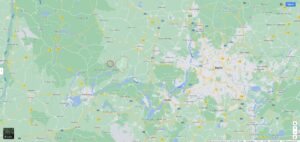
Oogling in more closely reveals Derben’s street layout. As is more evident in the images below, the target of the 8th Air Force’s January 14 mission – underground petroleum storage tanks – was not located in the town itself, but instead in the undeveloped (and still so today) wooded area adjacent to the eastern edge of the municipality…
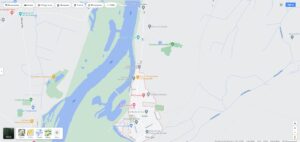
…which is revealed below, in an air photo at the same scale as the above map. Currently, the area – designated the Crosstreke Ferchland – is a location for motocross racing, evident by the numerous trails (designated in gray) through the area.

Likely photographed by an automatic bomb-strike camera, Army Air Force Photo 55871AC / A21154 shows the oil storage tank area near Derben at the beginning or in the midst of the 8th Air Force’s attack. This and the subsequent photo have been rotated, via Photoshop, such that they conform to geographic north, as in the maps above.
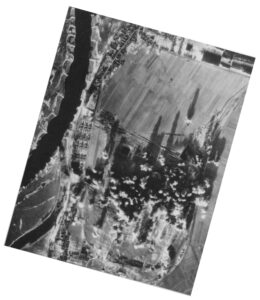
Also – presumably – photographed from the automatic camera of a higher aircraft, this Army Air Force photo (56022AC / A21155) shows a 390th Bomb Group B-17G – notice the square-J on the plane’s starboard wing? – flying north-northwest over the Elbe River. Due to the dispersal of smoke and debris from bomb explosions – obscuring a wider area than in the image above – this photo was probably taken subsequent to picture 55871AC. While the municipality of Derben appears to be undamaged, it looks (?) as if some bombs have fallen onto the uninhabited land to the west of the municipality, which would account for the billowing cloud of smoke rising into the sky from that location.

______________________________
________________________________________
______________________________
T/Sgt. Moe Hut
– .ת.נ.צ.ב.ה. –
…Tehé Nafshó Tzrurá Bitzrór Haḥayím …
May his soul be bound up in the bond of everlasting life.
3rd Air Division, 8th Air Force, 34th Bomb Group, 7th Bomb Squadron
This image of the 7th Bomb Squadron’s insignia is via ebay seller ez.collect.
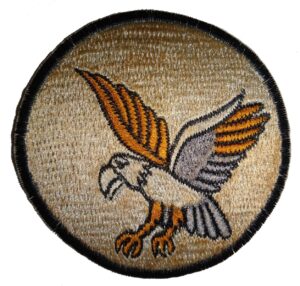
The 34th Bomb Group lost two 7th Bomb Squadron B-17s during its mission to oil storage facilities at Derben (though both MACRs list the target as “Brandenberg”), both to flak. Aircraft 43-38419, R2 * E, Miss Betsy, piloted by 2 Lt. Jacob T. Raver, crashed at Eggenstadt, Germany after a direct hit blew off most of its starboard wing, with only two crewmen – S/Sgts. Erwin W. Hanken (ball turret gunner) and Clayton Ervin (nose gunner) – surviving.
B-17G 44-8263, R2 * Y, Ol Buddy (assigned to the 7th Bomb Squadron on August 30, 1944) piloted by 1 Lt. Leslie C. Carter, experienced a nearly identical fate. According to MACR 11565, a flak burst in the plane’s right wing tore off the outer wing panel adjacent to the outboard engine nacelle, leaving only about a foot and a half of aileron. The plane rose slightly and veered into a nearly vertical bank to the right, and then went into a right spiral, which ultimately developed into a steep right spin. Luftgaukommando Report KU 3582 relates that the bomber, shot down by 2./Mar. Flak 224, crashed inland from the western coast of the state of Schleswig-Holstein, 3 kilometers southeast of Hastedt, along the road to Eggstedt.
The bomber’s crew comprised:
Pilot: Carter, Leslie C., 1 Lt.
Co-Pilot: Koch, Robert A., 2 Lt.
Navigator: Russell, John J., 1 Lt.
Bombardier: Rozell, Joseph E., 1 Lt.
Flight Engineer: Hut, Moe, T/Sgt.
Radio Operator: Guse, Leonard W., T/Sgt.
Gunner (Waist): Barreda, Fernando A., S/Sgt.
Gunner (Ball Turret): Belh, Robert C., S/Sgt.
Gunner (Tail): Romero, Cleveland J., Jr. – Survived
This Oogle map shows the probable crash location of Ol’ Buddy.
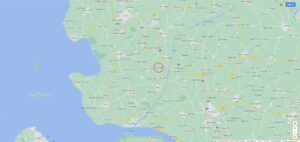
Only one survivor emerged from the nine crewmen aboard the bomber: He was S/Sgt. Cleveland J. Romero, Jr., the tail gunner, who parachuted from an altitude of 25,000 feet over the German coast, near the Frisian Islands. (See also…)
S/Sgt. Romero’s responses to Casualty Questionnaires in MACR 11565 were generally and inevitably similar from crewman to crewman. For example, in writing of ball turret gunner S/Sgt. Robert C. Belh, he stated, “All I know is that he didn’t have time to get out of the ball turret because the ship went down fast and in a tight spin. And that is one of the hardest spots on a ship to get out of in an emergency. All of my crew had plenty of confidence in the ship and pilot and would have waited until the last minute to bail out which may have been one reason why they didn’t get out in time.” (Sgt. Belh is buried in a collective grave with Lieutenants Carter, Koch (co-pilot), and Russell (navigator) at Zachary Taylor National Cemetery.)
Within the crew of Ol Buddy was T/Sgt. Moe Hut (12145645), the plane’s flight engineer. Writing of him, S/Sgt. Romero stated, “He was the engineer and I know he wouldn’t bail out if there would have been someone left in the ship. He went down with the ship as the others did. I’m sure he didn’t have time to get his parachute on because the ship went down very fast and in a tight spin.”
Born in the Bronx on February 4, 1923, Moe Hut’s wife was Ruth S. Hut, of 1659 Dahill Road in Brooklyn, and his parents Max (1890-7/6/50) and Gussie (1890-1978), of 8678 Bay Parkway, in Brooklyn, N.Y. Though his name appears on page 349 of American Jews in World War II, which notes that he only received the Purple Heart – suggesting that he completed less than five combat missions – it never appeared in any Casualty List for the New York metropolitan area. He was buried at Long Island National Cemetery (Section H, Grave 11517) in Farmingdale, New York, on June 6, 1950, but no obituary ever appeared in his name.
Sgt. Hut’s sixty-year-old father passed away exactly one month later, and is buried at Washington Cemetery in Brooklyn. Gussie lived until the age of eighty-eight, and is buried alongside her husband.
______________________________
______________________________
Moving to the 390th Bomb Group – the Group which suffered the most 8th Air Force losses this day – a summary of information about the Group’s B-17 losses follows. Data appears in the following format:
1) Aircraft serial number, aircraft squadron code letters, aircraft nickname, pilot’s name, fate of crew
2) Crash location
3) Missing Air Crew Report number, and, Luftgaukommando Report number
568th Bomb Squadron
Unlike most pictures of unit insignia featured at this blog, this image of the insignia of the 568th Bomb Squadron didn’t come from the Internet. Instead, this emblem was scanned from Albert E. Milliken’s 1947 book The Story of the 390th Bombardment Group (H).

42-31744, BI * A, Little Butch II, 1 Lt. Walter R. Wiegand, 9 crew members – 5 survivors
37 kilometers south of Neuruppin // 2 kilometers northwest of Goerne / 6 kilometers west of Friesack
11720, KU 3572
42-102677, BI * R / Mississippi Mission, 1 Lt. Gerald W. Johnston, 10 crew members – 5 survivors
3 kilometers east of “Garlitz” or “Garnitz” / 18 kilometers north of Brandenburg
11725, KU 3569
42-102956, BI * K / Doc’s Flying Circus, 1 Lt. Paul Goodrich, 9 crew members – 7 survivors
2 kilometers south of “Vietznitz” or “Vietnitz” / 3 kilometers south-southeast of Friesack
11726, KU 3570
43-38337, BI * N, Cloud Hopper, 1 Lt. Robert R. Richter, 9 crew members – 3 survivors
35 kilometers west-southwest of Neuruppin, near village of Dreetz (“Wolfsplan”)
11721, KU 3575
43-38526, BI * Z, Star Duster, 1 Lt. Louis F. Niebergall, 9 crew members – 6 survivors
27 kilometers southwest of Neuruppin
11722, KU 3567
44-6480, BI * E, 1 Lt. Daniel R. Thumlert, 9 crew members – 2 survivors
On Landstrasse (street) Ketzin, 3 kilometers from Ketzin / 13 kilometers south of Neuen
11826, KU 3561
44-8426, BI * G, 1 Lt. Alvin J. Morman, 9 crew members – 5 survivors
3.5 kilometers west of Wachow / 20 kilometers northeast of Brandenburg
11719, KU 3561
571st Bomb Squadron
Also from The Story of the 390th Bombardment Group (H) is this image of the 571st Bomb Squadron’s emblem.

42-102673, FC * B, Good-O Yank, 1 Lt. Joseph W. Lewis, 9 crew members, 4 survivors
2 kilometers northwest of Goerne / 6 kilometers west of Friesack
11724, KU 3574
43-38665, FC * Z, Queen of the Skies, 2 Lt. Emory R. Hanneke, 10 crew members – 1 survivor
40 kilometers southwest or west of Neuruppin / at “Bartschendorf”
11723, KU 3575
The picture of Queen of the Skies is American Air Museum in Britain photo UPL 30452, contributed by Lucy May.

______________________________
______________________________
F/O Jerome Joseph Katzman
3rd Air Division, 8th Air Force, 390th Bomb Group, 571st Bomb Squadron
Tuesday I go on “Flak leave” to a “Flak house.”
Flak is the stuff the Germans pop up at us.
After 20 missions or so they send us there for a week’s rest. I need it.
The war ain’t over yet over here.
Only four men survived the loss of B-17G 42-102673, Good-O Yank: co-pilot 2 Lt. Mike Klemenok, navigator F/O Jerome J. Katzman, togglier S/Sgt. Robert L. Battleson, and flight engineer S/Sgt. Kenneth E. Huber.
Also from the American Air Museum in Britain is this image of Good-O Yank, photo FRE 8214, I think from the Roger Freeman collection. Interestingly, the chin turret bears two nicknames: “BARBE – BETTE“.
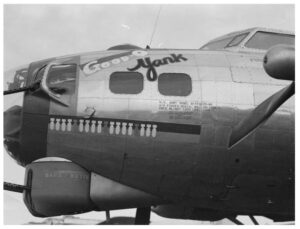
As described by Lt. Klemenok in a Casualty Questionnaire in MACR 11724, Lt. Lewis was last seen in the pilot’s seat carrying on his duties as aircraft commander. “At the time of attack the controls were turned over to the co-pilot while the pilot (Lt. Lewis) attempted to establish contact with lead ship of formation. It was found necessary to leave formation, due to wing fire extending to bomb load. Every attempt was made to extinguish flames. Being in command of the ship at that instant, the order to bail out was given. The pilot then took over with the intention of leaving by way of waist door and check the crew in so doing. Upon leaving the aircraft it was noticed that flames had already extended to just behind the flight deck and a glimpse while falling showed that the ship was a ball of flame. It is believed the aircraft was demolished by explosion.”
As evidenced by the fact that no survivors emerged from the aft section of the aircraft, Lt. Klemenok mentioned that the rear portion of the aircraft received the brunt of enemy attacks, being severely riddled by 20mm cannon fire, with flames from Good-O Yank’s fuel tanks extending to the bomb bay, in which the bomb salvo mechanism was inoperable.
The four survivors bailed out through the bomber’s nose hatch, the flight engineer last. All the while, Lt. Lewis was seen steadying the aircraft to enable the escape of his crew.
The aircraft exploded moments later.
F/O Katzman’s postwar report was far more succinct: “Did not leave sqdn formation. Sqdn. stayed with leader (Major McHenry) who straggled whole sqdn. All shot down.”
This image of Joseph Lewis’ crew is via the 390th Memorial Museum. Crewmens’ names are listed below the photo.

Rear, left to right:
Pilot: Lewis, Joseph W., 1 Lt. – KIA
Co-Pilot: Klemenok, Mike, 2 Lt. – Survived
Navigator (Mickey): In photo: Keelan, James E. (Not in this crew on January 14 mission)
Navigator: Not in photo: Katzman, Jerome J., F/O – Survived
Bombardier: In photo: Drusch, Edward W. – (Not in this crew on January 14 mission)
Togglier: Not in photo: Battleson, Robert L., S/Sgt. – Survived
Front, left to right:
Flight Engineer: Huber, Kenneth E., S/Sgt. – Survived
Radio Operator: Ruane, John V., Sgt. – KIA
Gunner (Ball Turret): In photo: McGowen (Not a crew member) (Not in this crew on January 14 mission)
Gunner (Ball Turret): Morrison, Earl Y., Sgt. – KIA
Gunner (Waist): Koralewski, John J., Sgt. – KIA
Gunner (Tail): Porcher, John W., III, Sgt. – KIA
Listed on page 359 of American Jews in World War II, F/O Jerome Joseph Katzman (T-129325) was imprisoned at Stalag 3A (Luckenwalde, Germany), his name appearing in a list of liberated POWs published on June 5, 1945. Born in Utica, New York, on September 27, 1918, he was the son of Nathan (1883-8/9/52) and Jennie (Cohen) (12/25/92-10/17/77) Katzman of 157 Pleasant Street, and brother of George and Morris. The recipient of the Air Medal with two Oak Leaf Clusters and Purple Heart, he completed 21 combat missions. He passed away on April 14, 2000.
The Ellen Freeman Bodow Family Tree at Ancestry.com features several fascinating documents and images pertaining to Jerome Katzman’s family and military service.
Though undated, this photo of the Katzman family – with Jerome at the upper right – evidently was taken prior to his departure for England.

In this picture, the Oak Leaf Clusters attached to Jerome’s ribbons reveal that the portrait was taken after his return from Europe.

The Ellen Freeman Bodow Family Tree also includes scans of a letter written by Jerome to his family on January 7, 1945 (he mistakenly lists the year as 1944), exactly one week before he was captured. The letter, addressed to a Freeman family in Utica (I don’t know the relationship), reveals a man with a direct sense of humor, whose writing was marked by frankness and brevity. I especially like the line, “Tuesday I go on “Flak leave” to a “Flak house.” Flak is the stuff the Germans pop up at us. After 20 missions or so they send us there for a week’s rest. I need it. The war ain’t over yet over here.” And, the enigmatic, “Was down to London last week again. Quite a town. I’m beginning to know quite a few people there & enjoy it immensely.”
The letter appears below, in a single composite image…

The letter…
Mr. & Mrs. L. Freeman
232 South St.
Utica, N.Y.
U.S.A.
7 Jan 44
Dear ole people & 3 kids,
Finally got time & ambitious enough at the same instant to set down & scribble a billet deaux. (?) Things here is much the same.
I got your package. Thanks a lot but I don’t like prunes & various. The whiskey was good but low in quantity. 1 qt. Bourbon would be really welcome. So I’ll make this a formal request for Cheese, Crackers & a jar of Mustard & etc. The Bourbon is the etc. Package it well & ship to me. I’ll sure appreciate it. Oh yeah, don’t put a return address on it so if the Postal Authorities get hip you can get fined for it.
Tuesday I go on “Flak leave” to a “Flak house.” Flak is the stuff the Germans pop up at us. After 20 missions or so they send us there for a weeks’ rest. I need it. The war ain’t over yet over here.
How about a little local gossip. I ain’t had nothin’ but Ellen Francis & Sue Lou in all the letters I get. Nor have I heard from Goldy. Will you please send me his address. Look Flo please do me a favor. I’ve told Mom a dozen times but it don’t do no good.
My address is:
F/O Me
571st Bmb. Sqdn. – 390th Bmb Gp.
APO 559, c/o Postmaster, N.Y.C., N.Y.
Please get it straight.
Was down to London last week again. Quite a town. I’m beginning to know quite a few people there & enjoy it immensely. Of course it costs pounds ($4.00 per pound). So 25 £ ain’t hay. It’s $100.00 bucks but what the hell. I’ve even been writing checks on my acct. back home. Oh well. That’s what it’s for. Might as well enjoy it.
I heard from Harold & Cissy & will answer them shortly.
England as usual is cold & wet. Central heating is a stove in the center of the room. You freeze to death here.
Not much else to write so will close with love to the kids.
Take care of yourselves.
Love
Jerry
______________________________
______________________________
2 Lt. Erwin M. Lutzer
3rd Air Division, 8th Air Force, 390th Bomb Group, 568th Bomb Squadron
Unlike Good-O Yank, most of the crew of Doc’s Flying Circus survived the shoot-down of their B-17. In a way perhaps representative of casualties aboard most of the 390th Bomb Group’s lost B-17s, pilot 1 Lt. Paul Goodrich and tail gunner S/Sgt. Leonard A. Losch never actually left the aircraft. Perhaps the former was wounded, or, he remained in the plane to ensure his crew were able to escape. The latter, because he was killed during attacks directed towards the rear of his aircraft by German fighters.
As reported by co-pilot 1 Lt. Raymond E. Thomas, Lt. Goodrich, ”… stood on [bomb-bay] catwalk and handed him [Lt. Goodrich] his parachute. I have no reason for his not leaving the ship unless he was wounded & didn’t know it. After I left the ship, I watch[ed] it fly in a fairly normal manner until I lost sight of it for reason or other,” while S/Sgt. Losch, “…called me over interphone & told me FW 190’s were coming in on the tail. The interphone was shot out right after that. (Found in aircraft.)” Unlike other 390th Bomb Group B-17 losses this day, Doc’s Flying Circus seems (?) not to have exploded in mid-air, instead crashing to earth relatively intact.
Otherwise, the seven survivors all safely parachuted from their B-17.
The navigator of Doc’s Flying Circus – 2 Lt. Erwin M. Lutzer (0-719973) – born in Richmond Hill, New York, on May 28, 1924, was the son of Harry Lutzer, who lived at 118-65 Metropolitan Ave., in Kew Gardens, New York. Shot down on his 28th mission, he was imprisoned at Stalag 7A in (Moosburg). Historical references about him comprise the appearance of his name in a Casualty List (specifically listing liberated POWs) published on June 20, 1945, and, brief articles in the Long Island Daily Press on November 3, 1944 (and June 20), and Long Island Star-Journal on April 12, 1945. American Jews in World War II, in which his name is recorded on page 385, lists his awards as the Air Medal and two Oak Leaf Clusters. He died on November 9, 1988.
This image of Paul Goodrich’s crew is via the 390th Memorial Museum. Crewmens’ names are listed below the photo.

Rear, left to right:
Flight Engineer: Thomas, Jim K., T/Sgt. – Survived
Gunner (Waist): In photo: Irwin, J. (Not in this crew on January 14 mission)
Radio Operator: Zadzora, George J., T/Sgt. – Survived
Gunner (Waist): Spence, Ralph K., S/Sgt. – Survived
Gunner (Ball Turret): Horan, James M., S/Sgt. – Survived
Gunner (Tail): Losch, Leonard A., S/Sgt. – KIA
Front, left to right:
Pilot: Goodrich, Paul, 1 Lt. – KIA
Co-Pilot: Thomas, Raymond E., 1 Lt. – Survived
Navigator: In photo: Nording, William L. (Not in this crew on January 14 mission)
Navigator: Not in photo: Lutzer, Erwin M., 2 Lt. – Survived
Bombardier: In photo: Shipplett, Wallace B. (Not in this crew on January 14 mission; KIA in Little Butch II)
Togglier: Not in photo: Piston, Frank H., Jr., S/Sgt. – Survived
______________________________
______________________________
T/Sgt. Martin Schwartz
3rd Air Division, 8th Air Force, 390th Bomb Group, 568th Bomb Squadron
Paralleling the fate of Good-O Yank, only half the crew of Little Butch II survived the loss of their B-17, amidst the most extreme circumstances possible: None of the crew actually exited the bomber through its escape hatches, for the plane exploded in mid-air, literally blowing the men into space, upon which the survivors – at least, those men able to do so – were able to deploy their parachutes. Perhaps this explains the fact that MACR 11720 only includes responses to Casualty Questionnaires by two of the plane’s five survivors: flight engineer T/Sgt. William L. Bongard, and waist gunner Sgt. Carl F. Packer.
As described by T/Sgt. Bongard, the pilot, 1 Lt. Walter R. Wiegand, “Did not have a chance to bail out.” Last seen on the bomber’s flight deck, he was pinned in the plane and could not escape before the aircraft exploded. His last words were, “Prepare to bail out. Let’s leave it men, too much fire.”
And also for co-pilot 1 Lt. Herbert O. Bracht, who like Lt. Wiegand was uninjured. T/Sgt. Bongard assisted the lieutenant in opening the bomber’s nose entry hatch, but the two were evidently (also) pinned in the aircraft until it exploded.
Likewise for 1 Lt. Wallace B. Shipplett, Good-O Yank’s bombardier. As reported to the sergeant by navigator 1 Lt. James R. Blaire, Shipplett, like Bracht, was, “Pinned in plane and could not get out. Aircraft exploded.
As for the fate of S/Sgt. Noble E. Barker, the bomber’s tail gunner, who suffered the same fate as Sgt. Losch of Doc’s Flying Circus. His last words were, “Bandits at six o’clock, let’s get em boys.”
Also via the 390th Memorial Museum is this picture of Walter Wiegand’s crew. The names of the men of Little Butch II are listed below…

Rear, left to right:
Co-Pilot: Bracht, Herbert O., 1 Lt. – KIA
Currie, S. (Training; not assigned to 390th BG)
Pilot: Wiegand, Walter R., 1 Lt. – KIA
Morley, E. (Training; not assigned to 390th BG)
Navigator: Not in Photo: Blaire, James R., 1 Lt. – Survived
Bombardier: Not in Photo: Shipplett, Wallace B., 1 Lt. – KIA (In crew photo of Doc’s Flying Circus)
Front, left to right:
Gunner (Tail): Barker, Noble E., S/Sgt. – KIA
Radio Operator: Schwartz, Martin, T/Sgt. – Survived
Gunner (Ball Turret): Richardson, Kenneth G., S/Sgt. – Survived
Togglier: Piston, Frank H., Jr., S/Sgt. – Survived (In crew of Doc’s Flying Circus on January 14 mission)
Flight Engineer: Bongard, William L., T/Sgt. – Survived
Gunner (Waist); Packer, Carl F., Sgt. – Survived
Among Little Butch II’s five survivors was the bomber’s radio operator, T/Sgt. Martin Schwartz (12147520), whose name appears on page 435 of American Jews in World War II. As clearly revealed in a hospital admission form in Luftgaukommando Report KU 3572 – in the original German document as well as its English-language translation – Sgt. Schwartz was severely injured by fire from attacking German fighters (he was struck in his left elbow by a machine gun bullet), and also – presumably – by the very explosion which enabled his survival. Hospitalized at Garrison Hospital 101 at Neuruppin on January 16, the document was “signed off” by a “Colonel Gruenwald”, a physician and the facility’s chief medical officer, whose signature is at the bottom of the form…

A fascinating document in this Luftgaukommando Report is a “Registration Form”, a one-sheet document formatted to record information revealed by any English-speaking POW from the American and Commonwealth air forces unwary enough to disclose classified information to his German captors. About a third of the Registration Form is comprised of fields for biographical information about a POW, with the remaining two-thirds pertaining to a flier’s history of military service, with a detailed focus on the circumstances under which he was shot down and captured, and, the composition of his crew. Though the Form’s title and labels are all in English (grammatically correct English, at that!) at the very bottom of the form, there’s a strange twist: A line of diminutive text stating, “S 6064 / 44 Heidelberger Gutenberg-Druckerei GmbH. X. 44”, which I think translates as, “S 6064 / 44 Heidelberger, Gutenberg Printing Limited – October 44”. In this, it’s startling that text revealing the form’s publication in Germany, implying its true purpose, would be visible on the document!
Here’s Sgt. Schwartz’s Registration Form…
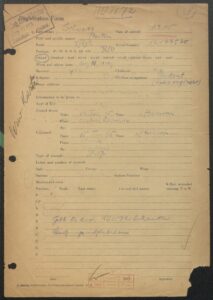
If you look closely (very closely!), you’ll see that the only information he revealed comprises the following:
Surname Schwartz
Date of Arrival 1.2.45
First and Middle Names Martin
Rank T/Sgt.
Serial-Number 12147520
Position R/O
When and where born Aug 11, 1922
Married (implying yes or no) no
Children (implying yes or no) no
Civilian occupation Student (radio engineer)
Forced Down:
Date 14 Jan 45
Time afternoon
Place central Germany
Captured
Date 15 Jan 45
Time afternoon
Place same
By civilians
Type of Aircraft B-17
What is evident is that Sgt. Schwartz didn’t fill out the form himself: his answers were presumably spoken, and then transcribed by his German interrogator, a Feldwebel Telten. How do we know this? The style of handwriting is identical among all data fields, and, both number 7s – in the Sergeant’s serial number “12147520”, and in “B-17”, are European style sevens, featuring a horizontal bar through the number. Sgt. Schwartz only revealed information that was obviously known to the Germans. And so, he was described by Telten as an, “Unsympathischer, ironisch grinsender, militarischer Angaben _____gender mensch. – “Unpleasant, ironically grinning man. Refuses to give military accounts.”
This characterization appears as a handwritten notation on the rear of the Registration Form, as seen below:
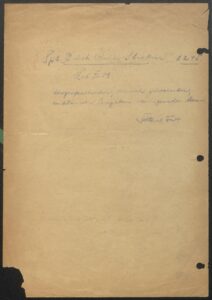
From Luftgaukommando Report KU 3572, this “Angabe über Gefangennahne von feindlichen Luftwaffenangehörigen” (“Information on the capture of enemy air force members”) form records Sgt. Schwartz’s capture at 1:30 P.M. near Friesack on January 14. The upper data fields note the crash of Little Butch II 37 kilometers south of Neuruppin.
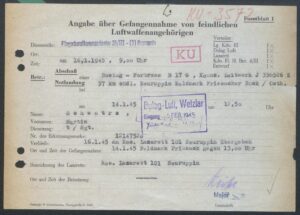
This document lists the items Sgt. Schwartz was carrying – or wearing … in the case of his dog-tags – upon his capture. (Something tells me that he never got anything back.) A German transcription and English-language translation of the document are given below.
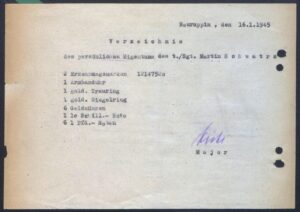
Neuruppin, den 16.1.1945
Verzeichnie
des persönlichen Eigentums des t./Sgt. Martin S c h w a t r z
2 Erkennaungsmarken 1214752o
1 Armbanduhr
1 gold. Trauring
1 gold. Siegelring
6 Geldmünzen
1 1o Schill.-Note
6 1 Pfd. -Noten
— translation —
Neuruppin, January 16, 1945
Directory
of the personal belongings of T/Sgt. Martin S c h w a t r z [sic!]
2 identification tags 12147520
1 wrist watch
1 gold wedding ring
1 gold signet ring
6 cash coins
1 10 shilling note
6 1 pound note
Martin Schwartz was born in Brooklyn on August 11, 1922 to Harry and Yetta (Felsher) Schwartz, at 705 Saratoga Avenue. Eventually interned at the Hohe Mark Hospital, his name appeared in a Casualty List (listing the names of liberated POWs) published on June 19, 1945, and, on page 450 of the Story of the 390th Bomb Group. The recipient of the Air Medal with one Oak Leaf Cluster and Purple Heart, he flew 29 combat missions. His name appeared in a list of liberated POWs published in The New York Post (and The New York Times) on June 16, 1945, as seen below.

Sgt. Schwartz (subsequent to 1945, I suppose just “Martin Schwartz”?!) passed away in Fort Lauderdale, Florida, on January 23, 2000. And so, unfortunately, I never had the opportunity to contact and possibly interview him about his wartime experiences. (Then again, given the commonality of this name – and no middle initial – in a nation of over three hundred million people, how could he ever have been located?!).
______________________________
______________________________
1 Lt. Jack Aaron Simon
3rd Air Division, 8th Air Force, 390th Bomb Group, 568th Bomb Squadron
The accounts of the losses of THE COLUMBUS MISS / Egg Haid, Ol Buddy, Good-O Yank, and Little Butch II are derived from statements by surviving crewmen from those aircraft, or, eyewitness reports by aviators in nearby planes. However, the case of un-nicknamed Flying Fortress BI * G (44-8426) is very different, for the story of the aircraft’s loss – below – comes directly from a Casualty Questionnaire completed by one of the bomber’s surviving crewmen, First Lieutenant Jack Aaron Simon (0-466826), the plane’s navigator. In terms of historical records, Jack Simon’s story is representative of what can be found in a very small number of Missing Air Crew Reports, which are significant in featuring extremely detailed write-ups, through which a surviving crew member will relate the events of a mission – a crew’s final mission – in a detailed, story-like fashion.

And so, here’s a verbatim transcript of Jack Simon’s story. (What’s particularly sad about the tale is the fact that Lieutenants Morman and Vevle, the aircraft’s pilot and co-pilot, were still alive and entirely uninjured at the moment when Lt. Simon left the aircraft via the forward escape hatch…)
This Oogle map shows BI * G’s probable crash site…

On January 14, 1945, in an operational flight over Germany, our plane was part of a squadron attacked by a large force of enemy fighters. Shortly after the initial assaults, the interphone having been made inoperative immediately, the engineer was observed abandoning the ship. Learning by signals that we were going down, the toggelier was alerted and preparation made to leave also. At the time of the communicating with the engineer who was at the escape hatch near the nose, the copilot, Lt. Vevle, was observed standing in the escape hatch behind the engineer. With the engineer gone, I entered the escape hatch and stood up beside Lt. Vevle and verified by signs that we were going down (wing fire not visible from nose) and that he and the pilot, Lt. Morman were alright. With that information, I left the ship. The toggelier, Sgt. Springborn, leaving the ship only seconds later apparently, states than no one was standing in the escape hatch, and though from his position he could not be sure, he does not believe there was anyone in the pilots compartment. (From personal conversations later.) The engineer also verified at the time of his leaving the ship the pilot and co-pilot were uninjured. When I bailed out, I landed a few kilometers southeast of the small town of Freysach (spelling?) Germany. It is my understanding that Sgt. Manfredini, Sgt. Springborn, and Sgt. Barton all landed within a few miles radius.
The following paragraph is further Information gleaned from conversations with Sgt. James F. Stieg, the lower turret gunner. Despite the visible fire, he remained at his position in the turret until he was wounded in the leg. He crawled out of his turret and found the bodies of Sgt. Leon Cousineau and Sgt. Robert Hehr waist gunner and radio operator respectively, lying in the waist. He made an effort to revive both, but found that both had apparently been instantly killed. Manning a waist gun against fighters which continued to attack, until wounded again, he then tried to get out the waist escape hatch, but was unable to get the door off, because the emergency release would not operate. He estimates this action consumed approximately fifteen minutes which is substantiated by the fact that he landed near Potsdam. Being unable to get out, and in a weakened condition, he endeavored to protect himself from flames then entering the fuselage when the ship blew up, hurling him into space where he was able to parachute to safety. Because of the erratic flight of the aircraft, he assumes that the ship was flying out of control. Although he did not go forward of the radio room, he feels that there was no one in the pilot’s compartment.
The only additional information was obtained from the German colonel who interrogated me, who for some unexplainable reason called me in just before my release from the interrogation center to inform me of the disposition of my crew. According to his statement, the bodies of Lt. Vevle, Lt. Morman, Sgt. Cousineau and Sgt. Hehr were found in the airplane. The others were accounted for as prisoners of war except for Sgt. Stieg, regarding whose whereabouts he was uninformed. At that time, it was later learned from Sgt. Stieg, he was in a hospital in Berlin. It is possible that a more exact position of where the aircraft crashed may be obtained from Sgt. Stieg.
As above, the 390th Memorial Museum is the source of this photo: The crew of Alvin Morman. The names of the airmen of BI * G follow…

Rear, left to right:
Flight Engineer: Manfredini, Mario J., T/Sgt. – Survived
Radio Operator: Hehr, Robert G., T/Sgt. – KIA
Gunner (Waist): Cousineau, Leon J., S/Sgt. – KIA
Gunner (Ball Turret): Stieg, James F., S/Sgt. – Survived
Unknown
Gunner (Tail): Barton, Samuel W., S/Sgt. – Survived
Front, left to right:
Pilot: Morman, Alvin J., 1 Lt. – KIA
Co-Pilot: Vevle, Floyd Martin, 1 Lt. – KIA
Navigator: Simon, Jack A., 1 Lt. – Survived
Togglier: In photo: Senseny, Eugene F. (Not in this crew on January 14 mission)
Togglier: Not in photo: Springborn, Robert C., Sgt. – Survived
Born in Champaign, Illinois, on June 17, 1919, Lt. Simon, who completed 27 missions, was awarded the Air Medal and three Oak Leaf Clusters. Imprisoned at Stalag 7A, his name appears on page 117 of American Jews in World War II, and, page 448 of the Story of the 390th Bomb Group. The son of Abraham (12/24/88-10/7/64) and Lenore Sarah (Levy) (5/29/95-4/6/84) Simon, and brother of Harold and Robert, his family resided at 502 West Oregon Street, in Urbana.
Though the specific date on which Jack Simon wrote his account of the fate of BI * G for the Army Air Force is unknown (well, let’s assume it was in the latter half of 1945, or, 1946), it was almost certainly preceded by similar document of much greater scope and detail. This was Jack’s essay Four Months A Prisoner of War in 1945, which was composed on July 25, 1945, after his return to Urbana. Vastly expanding on his write-up for the MACR, Four Months encompasses (very briefly) events preceding the shoot-down of the Morman crew, the events of the Derben mission, his capture and interrogation, his imprisonment at Nuremberg, a forced march to Moosburg near the war’s end, his liberation, returning to Urbana, and in closing, reflections on the past from the very (very) short vantage point of the summer of 1945.
One of the closing paragraphs is speculation on the fate of his pilot and co-pilot. Namely, “…I heard from Gene Senseny, our bombardier who had not flown with us the day we went down. He had completed his missions, had come home and was discharged soon after reassignment. I had hoped to see him while I was home, but haven’t gotten to yet. As for the other boys, three of the families received notice of killed in action, but Vevle the co pilot wasn’t reported. I’ve held out hope for a miracle here, but time is an enemy in that regard. I am convinced that Floyd Vevle and Alvin Morman [pilot] gave their lives in an attempt to assure the safety of the remainder of the crew. Because of a failure of the alarm system and the interphone, I think Floyd may have attempted to warn the boys in the rear part of the ship while Alvin remained at the control. Both had their chutes on before I knew we were going down. Yet, the toggelier reported no one in the hatchway when he went out. On this assumption, I’m making an effort to get them some recognition for their act. They were wonderful boys, and so selfless, that I know they could not have done any differently.”
____________________
The Second World War eventuated in great tragedy for the Vevle family. Prior to Floyd Vevle’s death on January 14, 1945, his twin brother, 1 Lt. Lloyd Oliver Vevle – remarkably, also a B-17 co-pilot in the 8th Air Force – was killed on September 28, 1944 while serving in the 545th Bomb Squadron of the 384th Bomb Group. A crew member of 1 Lt. James J. Brodie in B-17G 42-31222 (Lazy Daisy), his aircraft was involved in a mid-air collision with B-17G 43-37822 of the 544th Bomb Squadron, piloted by 1 Lt. John O. Buslee. Of the eighteen men aboard the two aircraft, there emerged four survivors: Three from Brodie’s bomber (navigator 2 Lt. George M. Hawkins, Jr., and gunners Sergeants Alfred F. Miller and Harry A. Liniger) and a single man from Buslee’s (waist gunner S/Sgt. George Edwin Farrar).
Writer Cindy Farrar Bryan, George Farrar’s daughter, has done extraordinarily thorough research about her father’s military experiences (particularly focusing on the mission of September 28, 1944) in the larger context of researching her family’s history. Her work can be found at The Arrowhead Club, with her chronicle of the lives of the Vevle brothers appearing at The Vevle Twins.
Lloyd Oliver Vevle is buried at the Ardennes American Cemetery, while his brother Floyd Martin – whose body has never been found – is commemorated at the Henri-Chapelle American Cemetery.
The Vevle brothers had one surviving sibling: Rudolph Bernhardt Vevle, born in 1912, who died in 2000.
____________________
Subsequent to his return to Urbana, Jack Simons returned to his career as a geologist, having acquired a Bachelor’s degree in the subject from the University of Illinois in 1941, and a Master’s Degree by 1946. He served as Chief of the Illinois Geological Survey from 1975 through 1982, when he retired for health reasons. He passed away at the age of seventy-six on December 17, 2005.
Four Months remained unpublished during his lifetime, and was only made publicly available in 2007, one year after his passing. As related in the document’s Preface, he “…gave Paul DuMontelle [Senior Geologist Emeritus at the Illinois Geologic Survey] a typed copy of his story several years before he passed away, but being the gentleman that he was, he did not share this wartime story with his colleagues, which inspired this printing.” Now in 2023, the document remains available through the HathiTrust.
The following five illustrations are from Four Months.
Here’s a list of the Morman crew’s combat missions from October 7, 1944 through January 14, 1945, as compiled by Jack Simon in 1987…

“Jack Simon (center) with his pals, his pilot and co-pilot,” Lieutenants Morman (left?) and Vevle (right?)…

“Jack Simon and three crew members dressed and ready for high-altitude cold.”…

“Jack Simon’s identity paper as a prisoner of war.”…
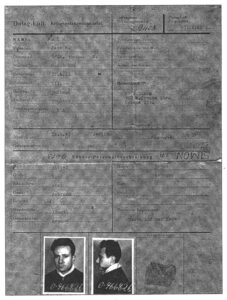
“A letter home on POW supplied paper. In his letters, Jack Simon refers to the family of Dr. Gilbert H. Cady, who was at the time the Head of the Illinois State Geological Survey’s Coal Section and who lived next door to the Simon family on Oregon Street in Urbana.”
The text of the letter appears below…
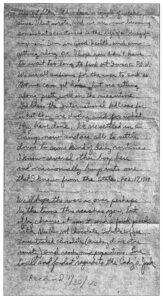
Dearest folks, It has been a couple of weeks since I lasty wrote, and we are now becoming somewhat accustomed to the life of a “Kriegsfangener.” I’m in good health and am getting along O.K. I hope you didn’t have to wait too long to find out I was a P.O.W. We are all anxious for the war to end so that we can get home but are getting along pretty well in the meantime. God bless the International Red Cross for what they are doing and for what they have done. We are settled in a camp now and are able to settle down to some kind of daily routine. I know several other boys here and occasionally bump into one that I know from the States. Feb. 17, 1944
We’ll hope the war is over perhaps by the time this reaches you, but if by chance it won’t, send a food parcel with Nestles Hot Chocolate, Soluble coffee, concentrated chocolate (Hershey dime store variety) and ready mix preparations. Love to all and fondest regards to the Cady’s.
Jack
Received 1/30/46
This portrait from Memorial to Jack Aaron Simon (1919–2005), by Morris W. Leighton and Harold J. Gluskoter, shows him during his professional, post-war life.

______________________________
______________________________
Flight Officer Israel Mayo Larkin (Latkowitch)
3rd Air Division, 8th Air Force, 487th Bomb Group, 838th Bomb Squadron
The burgomeister ordered a search and compelled me to undress myself.
He then forced me to stand at attention while numerous telephone calls were being made
and I was questioned separately about each article of my personal effects.
They wanted to find my papers.
They asked me for my papers.
I told them I had no papers.
They insisted I had papers and they took apart my emergency medical kit
and asked me to explain that.
The search disclosed a Jewish bible which I was carrying.
I was asked if it belonged to me and I answered “Yes” and it caused a mild sensation.
The burgomeister asked me why I had come back to Germany,
didn’t I know what they did to the Jews…
Jack Simons’ Four Months a Prisoner of War in 1945 carries the following enigmatic passage, “Around midnight, however, we were taken downstairs, searched again and the more fortunate ones received most of their clothing back although mine was all gone by the time I got there. It was some relief to be in the hands of the army, but though I had received no roughing up by nature of my religious origins, one of the boys whose name and face were not very inconspicuous, had been pushed around a bit and spat on, but what the military would do remained to be seen. Most of the way through, we were so much more fortunate than a great many of the boys that I’ve talked to that I almost hesitate to recount it, but it is simply explainable I think, in that it all depends who gets their hands on you.”
Given the ambiguity of Simons’ account, it’s impossible to identify the man, “…whose name and face were not very inconspicuous…” He could have been F/O Katzman, Lt. Lutzer, or Sgt. Schwartz. Indeed, he may not have been Jewish at all. But, there was one man shot down on the Derben mission, whose experiences upon being captured were vastly worse than those endured by Simons’ anonymous airman. That aviator was Flight Officer Mayo Israel Larkin (Latkowitch) (T-132318), the navigator of B-17G Our Baby of the 487th Bomb Group’s 838th Bomb Squadron.
This image from the 487th Bomb Group Association shows Lt. Moser and the crew of Our Baby.
x

Front, left to right:
Pilot: Moser, James L., 2 Lt.
Co-Pilot: Summerlin, Conrad P., 2 Lt.
Navigator: Larkin, Mayo I., F/O
Bombardier: Kenney, Lt. Paul E., 2 Lt.
Rear, order unknown:
Flight Engineer: Flanery, Coy L., Sgt.
Radio Operator: Leo, Orland D., Sgt.
Gunner (Ball Turret): Ketcham, Robert L., Sgt.
Gunner (Waist) Weisman, Kenneth W., Sgt.
Gunner (Tail): Sahlstrom, Hubert R., Sgt.
The four 487th Bomb Group B-17s lost on January 14, 1945, comprised:
42-98013, 2C * M, 1 Lt. Clement J. Kochczynski, 9 crew members – 4 survivors
Near Wentschau, 33 kilometers east southeast of Lueneburg
11734, KU 3571
43-38002, Our Baby, 2 Lt. James L. Moser, 9 crew members – all survived (F/O Larkin’s plane)
Village of Rhode (border of village into church), 9.5 kilometers northwest of Air Base Helmstedt
11733, KU 3562
43-37933, 4F * C, Yankee Maid, 2 Lt. Harry T. Nyland, 9 crew members – 8 survivors
Between Redefin and Gross Krams, 12 kilometers south of Hagenow
11732, KU 3560
44-8563, 1 Lt. Omar D. Stemple, 11 crew members – 9 survivors
Near Gutenpaaren, 26 kilometers northwest of Brandenburg
11731, KU 3559
Two of these bombers were lost due to a mid-air collision. 2C * M (42-98013), as described in MACR 11734, was assumed to have collided with Yankee Maid (43-37933), then peeled off to the “right” to head northwest, with its rudder knocked off and dorsal turret damaged. Initially seen to maintain its altitude while remaining under control, 2C * M eventually exploded with the loss of four crewmen. This was the crew’s first combat mission, and the 36th for pilot Clement Kochczynski (he’d already completed his assigned tour of missions) who did not survive.
However… In reality, 2C * M struck Our Baby (43-38002), the crew of which was forced to parachute. As reported by Larkin after the war, “At bombs away an aircraft on my left contacted my aircraft shearing major portion of left wing and empianage. [sic] We were forced to leave the plane by chute [at 27,000’]. / Pilot, Co-Pilot, Eng., Nav., Bomb., R.O. bailed out open bomb bay, W.G., Ball Turret & Tail bailed out waist door. Plane had major battle damage at time of bomb run.”
Our Baby probably crashed at the location designated by the red oval.

Lt. Stemple’s 44-8563 was shot down by enemy planes, leaving nine survivors.
As for 43-37933, Yankee Maid, Lt. Nyland wrote after the war that his parents received an incorrect account of his bomber’s loss, which listed the wrong target, and, attributed his plane’s loss to the above-mentioned mid-air collision. In reality, Yankee Maid lost its #4 engine, fell out of the 487th’s formation, and was attacked by six Me-109s, of which four were claimed by the bomber’s gunners.
Very many of my posts have touched upon the subject of the experiences of prisoners of war, “in general” – a perennial aspect of military conflict, and, the fate of Jewish prisoners of war in captivity of Nazi Germany, “in particular” – a situation unique to the Second World War.
The case of Flight Officer Larkin exemplified the potential dangers of the latter. Immediately upon being identified as a Jew he was subject to physical and psychological mistreatment by his captors. This commenced upon his arrival at the German town of Helmstedt, continued the same day at Halberstadt, reached its worst culmination in Magdeburg on January 15, and only ceased when – in the company of five other American POWs; fellow crew members from Our Baby – he departed the latter city for Frankfurt am Main. Though he was no longer singled out for mistreatment while enroute to the latter destination, the group was subjected to a civilian’s verbal harangue with an explicitly intended threat of murder, which, given the apathy and open agreement of their guards, might have happened if not for the fortuitous arrival of a streetcar. (A very similar experience was endured by S/Sgt. Theodore L. Solomon (Satmary) of the 815th Bomb Squadron, 483rd Bomb Group, ball turret gunner of the B-17 Bunky, after having been shot down on July 18, 1944.) Eventually arriving at Stalag 3A (Luckenwalde), F/O Larkin remained at that camp until his liberation by Russian troops, reaching American lines on May 6, 1945.
Flight Officer Larkin was interviewed about his experiences on July 20, 1945, at the Headquarters of the First Service Command, 808 Commonwealth Avenue, in Boston, by special agent Edward M. Conley of the Security and Intelligence Corps, his answers having been recorded by Vince A. Creeden, a civilian employee of the First Service Command’s Intelligence Division. Though agent Conley’s line of questioning was extremely thorough and very perceptive, unsurprisingly (well, to the best of my knowledge) nothing further eventuated from the information provided by Flight Officer Larkin, in the way of investigation or identification of the civilians or military personnel responsible for his mistreatment. I would think that this was because he simply never knew (and never could have learned) the identities of his captors at Helmstedt, Halberstadt, and Magdeburg, though I’m certain records of these mens’ identities still exist… Much more pragmatically, during the first Cold War these cities fell into the Soviet Zone of occupation and eventually were part of the German Democratic Republic. Of equal and ironic pragmatism (?!), the totality of his experience didn‘t reach the gravity of other war crimes.
Finally and simply, Mayo Larkin endured and came through his experiences to have a successful and productive postwar life.
Here are some excerpts from F/O Larkin’s interrogation by Agent Conley, as recorded in Judge Advocate General’s Office Case Files 12-1975, 12-1976, and 12-1977 of NARA Records Group RG 153.
At Helmstedt…
I was captured by the Volksturm and was marched through the town of Helmstadt. I was escorted by civilians. One civilian struck me with his bicycle. I was taken to the burgomeister and searched. The search disclosed a Jewish bible among my possessions, which served as motivation for mistreatment. I was beaten by the burgomeister; that is, struck on the head causing a fracture of the nose, black eyes and bleeding. I was held during this time by two German soldiers who, I believe, were SS men. My clothing was removed and I was compelled to travel in underwear and stockings from this point.
The burgomeister ordered a search and compelled me to undress myself. He then forced me to stand at attention while numerous telephone calls were being made and I was questioned separately about each article of my personal effects. They wanted to find my papers. They asked me for my papers. I told them I had no papers. They insisted I had papers and they took apart my emergency medical kit and asked me to explain that. The search disclosed a Jewish bible which I was carrying. I was asked if it belonged to me and I answered “Yes” and it caused a mild sensation. The burgomeister asked me why I had come back to Germany, didn’t I know what they did to the Jews, and he insisted that I could speak German, and I told him I did not understand German. The burgomeister got up from behind his desk, came over to me and struck me and two guards held me while he did it.
At Halberstadt…
Q. Where were you taken?
A. I was put in an automobile and driven to Halberstadt, about an hour’s ride, and taken to what I believe was the Gestapo headquarters.
A. He exchanged greetings with the usual Hitler salute and informed the person sitting behind one of the four desks that I was a Jew and made quite a joke out of it, and he also brought greetings from the burgomeister of Helmstadt with the additional comment that they should take care of me because I was a Jew.
Q. How did the guard know that you were a Jew?
A. I carried a Jewish bible on my person when I was captured and it was found by the burgomeister when I was searched in Helmstadt. The guard was told by the burgomeister, when he came to transport me to Halberstadt, that I was a Jew and that the information should be carried to the next source.
At Magdeburg…
A. He was sort of half sitting and standing on the corner of a desk and he got up and said, “I am tired of wasting time with you. I have lost my patience with you. Have you ever heard of the Gestapo?” I answered, “No.” He then said, “Do you know what the Gestapo means?” I said, “No,” and then he shouted, “Gestapo! Gestapo! Dick Tracy! Dick Tracy!” and I couldn’t help smile, and, when I smiled, he became infuriated and began to beat me.
Q. With what did he beat you?
A. His fists.
Q. How many times did he strike you?
A. About three or four times, twice on the back of the head behind my ear.
Q. Were the blows painful?
A. No, they merely stunned me.
Q. Did you sustain any injuries as a result of his beating?
A. I couldn’t distinguish this particular injury from those I had received before. It all seemed continuous.
Q. What other mistreatment did he subject you to?
A. He drew his pistol and placed it between my eyes and said something to the effect that, if you don’t know what the Gestapo means, maybe this will show you – – something similar to that only he was saying it to the other Germans in the room. “If he doesn’t know what the Gestapo is, when he sees this, he will know.” He pulled the trigger and the pistol failed to fire as it apparently was not cocked. Then he cocked the pistol and, as he did so, I heard a round go into the chamber. I then pleaded for time in an attempt to stall, telling him I was so confused, excited, weak, and tired that I couldn’t think clearly and would tell him all he wanted to know if he would just wait until tomorrow morning. He then placed the pistol back in its holster and conferred with the other Germans in the room and I was then taken back to my cell. Early the following morning I was taken from my cell; some of my crew were picked up and we were taken to a train station to board transportation for Frankfurt am Main.
At Frankfurt am Main train station…
He said that we were murderers; that we bombed civilians; that we killed women and children. He shouted, “Look at what you have done to these homes,” because we were standing in the center of the city. He turned to the civilians around and said that we ought to be hung and turned back to us and, shaking his cane, said that the Germans didn’t kill prisoners of war. He shouted, “Your Army is not worth a — I cannot recall the words he used — all you know how to do is to bomb; you don’t fight like soldiers; you wait two or three months; you will see what will be; in the last war, we quit at ten minutes of twelve; this war we will begin at ten minutes after twelve.” Then he turned back to the crowd and continued his harangue.
From Luftgaukommando Report KU 3562, this “Angaben über Gefangennahne von feindlichen Luftwaffenangehörigen” (“Information on the capture of enemy air force members”) – different in format from that for Sgt. Schwartz – records F/O Larkin’s capture at 2:30 P.M. near Rhode on January 14. The upper data fields note the crash of Our Baby at 1:30 P.M. on the same day, 9 ½ kilometers northwest of that town. In the upper right of the form, a detail-oriented member of the Luftwaffe penciled in the identifying letter of the 487th Bomb Group (“P“), Our Baby’s serial number (“338002“), and the aircraft’s individual plane-in-squadron identifying letter (“C“).
 Mayo Israel Larkin was born in Allston, Massachusetts, on July 25, 1916, the son of Julius and Francis (Szathmary) (8/5/90-5/15/66) Latkowitch, of 75 Aldie Street, in Allston. This is his portrait from the 1938 class yearbook of the Massachusetts College of Art and Design, via Ancestry.com.
Mayo Israel Larkin was born in Allston, Massachusetts, on July 25, 1916, the son of Julius and Francis (Szathmary) (8/5/90-5/15/66) Latkowitch, of 75 Aldie Street, in Allston. This is his portrait from the 1938 class yearbook of the Massachusetts College of Art and Design, via Ancestry.com.
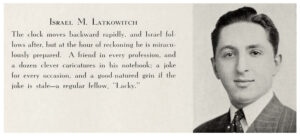
Like so very many of the American Jewish WW II soldiers mentioned at this blog, his name never appeared in American Jews in World War II. An architect postwar (partner in the firm Larkin & Glassman Associates and member of the Boston Society of Architects) he was married to Martha (Goorno) Larkin (7/1/17-1/9/01) and passed away on June 16, 2011. He’s buried next to his wife at Sharon Memorial Park, in Massachusetts.
He can be seen in this photo from his obituary at Legacy.com, in a picture from the Goorno Family.

________________________________________
____________________
________________________________________
References
Books
Astor, Gerald, The Mighty Eighth: The Air War in Europe as Told by the Men Who Fought It, Dell Publishing, New York, N.Y., 1997
Dublin, Louis I., and Kohs, Samuel C., American Jews in World War II – The Story of 550,000 Fighters for Freedom, The Dial Press, New York, N.Y., 1947
Freeman, Roger A., The Mighty Eighth – A History of the U.S. 8th Army Air Force, Doubleday and Company, Inc., New York, N.Y., 1970
Freeman, Roger A., The B-17 Flying Fortress Story – Design – Production – History, Arms & Armour Press, London, England, 1998
Milliken, Albert E. (editor), The Story of the 390th Bombardment Group (H), N.Y., 1947
Richarz, Wilbert H., Perry, Richard H., and Robinson, William J., The 390th Bomb Group Anthology – Volume I, 390th Memorial Museum Foundation Inc., P.O. Box 15087, Tuscon, Az., 1983
Richarz, Wilbert H., Perry, Richard H., and Robinson, William J., The 390th Bomb Group Anthology – Volume II, 390th Memorial Museum Foundation Inc., P.O. Box 15087, Tuscon, Az., 1985
Simon, Jack A., Four Months a Prisoner of War in 1945, Illinois Department of Natural Resources, Champaign, Il., 2007 (via HathiTrust)
Other Documents
NARA Records Group 153 (Records of the Office of the Judge Advocate General), Case Files 12-1975, 12-1976, 12-1977
12-1975: In the matter of the beating of Flight Officer Mayo Israel Larkin, USAAF, by the German burgomeister at Helmstedt, Germany, 14 January 1945.
12-1976: In the matter of the beating by German officials of Flight Officer Mayo Israel Larkin, USAAF, at Halberstadt, Germany, 14 January 1945.
12-1977: In the matter of the beating by German officials of Flight Officer Mayo Israel Larkin, USAAF, at Magdeburg, Germany, 14 January 1945.
Websites
Wayne’s Journal – A life of a B-25 tail gunner with the 42nd Bombardment Group in the South Pacific – January 14, 1945
WW2Aircraft.net – Details of air battles over the West on January 14, 1945 (Primary emphasis on encounter between fighter aircraft of Eighth Air Force and Luftwaffe)
WW II Aircraft Performance – Encounter Reports of P-51 Mustang Pilots (Includes reports for January 14, 1945)
Tempest V Performance – Combat Reports (Includes four Reports for January 14, 1945)
390th Memorial Museum Foundation – Database (390th Memorial Museum’s Research Portal)
-and-
390th Bomb Group Works Cited
The Story of the 390th Bombardment Group (Paducah: Turner Publishing Company, 1947), 65-66.
“390th Bomb Group: History of Aircraft Assigned.” Unpublished manuscript. 390th Memorial Museum. Joseph A. Moller Library.
“390th Bomb Group Tower Log: November 22, 1944 – June 27, 1945.” Unpublished manuscript. 390th Memorial Museum. Joseph A. Moller Library.
“Mission – No. 243, Target – Derben, Germany, Date – 14 January 1945.” Mission Reports Part I, MISSION_REPORTS_03, file no. 1266-1267. Digital Repositories. 390th Memorial Museum. Joseph A. Moller Library.














































